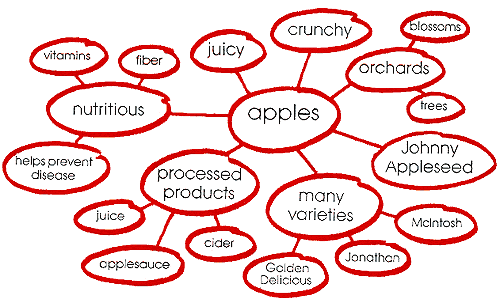Hello fellow Christians & Homeschoolers!
 Have you heard of the instructional strategy called “semantic mapping”? It is basically a graphic organizer–the organizing of words and meanings around a topic you want your child to learn. You use this strategy when you want your child to build upon his prior knowledge; or what he already knows about the topic. It can also be used as a prewriting activity. First draw a circle and write the topic word in the middle of the circle. Then you draw straight lines going outward from the circle. Be creative and make your circle into a spider. Each line represents a subtopic of your topic. At the end of each line write the subtopic.
Have you heard of the instructional strategy called “semantic mapping”? It is basically a graphic organizer–the organizing of words and meanings around a topic you want your child to learn. You use this strategy when you want your child to build upon his prior knowledge; or what he already knows about the topic. It can also be used as a prewriting activity. First draw a circle and write the topic word in the middle of the circle. Then you draw straight lines going outward from the circle. Be creative and make your circle into a spider. Each line represents a subtopic of your topic. At the end of each line write the subtopic.
For example, for the topic word “dog” you might have the following subtopics:
- physical characteristics
- language
- sporting dogs
- working dogs
- companion dogs
- dog food
Next, instruct your child to give details explaining and giving examples of each subtopic. For example,
- Companion Dogs – Dogs that are pets. Examples include collies and miniature poodles
Ask your child to think of as many words as he or she can that are related to the subtopic word(s). Brainstorm with your child. Model this procedure to your child. When he cannot write any more details describing each subtopic, refer him to a book or internet research to finish his graphic organizer. Once your child learns how this works, you can instruct your child to create his own graphic organizer after you give him a topic. Here’s an example document (click on text to view link to document and enable editing): graphic organizer. I also found a great site to click on called GraphicOrganizers that gives you free printable graphic organizers for all grade levels.
I successfully used this strategy almost daily in my classes. It is very effective in building vocabulary. It helps students more clearly understand word relationships.
I successfully used this strategy almost daily in my classes. It was very effective in building vocabulary. It helps students more clearly understand word relationships.


Great way to organize our thoughts and ideas!
Thanks. I agree!
Yes, it is a great tool.
With schools being so void of values these days and with there being so many problems (financial and otherwise) with public or charter schools, I think more and more Christians and those of other faiths with a value-based mindset will be doing more homeschooling. For Christians and others doing homeschooling you have provided some valuable tips and home school tools and tips to help parents more effectively teach their children or homeschoolers. Many parents are not trained and to have a valuable resource like this is great.
You are definitely making a difference by using your professional teaching experience in providing parents opting for homeschooling for their kids with invaluable training and homeschooling techniques and resources.
Thanks for the great service you’re providing!
Thanks for your great support. I do think homeschooling is definitely on the rise.
Thanks. I do hope homeschoolers will find this resource invaluable.